MID battle: Aigo P8860 (Intel) vs. Archos 5 (ARM)

Even though Archos isn’t using the “MID” term to describe its new range of Internet Media Tablets, there’s no denying that it is a mobile internet device with many of the same capabilities and even some of the same design elements as Intel’s original vision. So when Rob Enderle called the Archos 5 “the closest thing to what Intel is imagining in a MID currently in the market,” I took it as an open invitation to pit the new Archos (arguably the best ARM MID around right now) against the Aigo P8860 (the first Intel MID to be available worldwide).
Read on to see how the two devices stack up and decide for yourself which one comes out on top.
But first, a word about target audience.
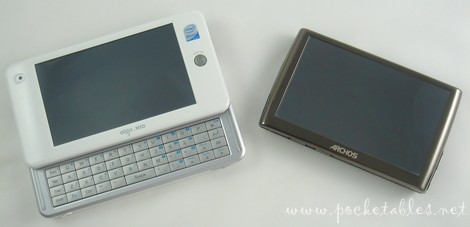
The Aigo P8860 and Archos 5 aren’t meant to be competitors; in fact, they’re not even really designed to appeal to the same kind of user. There’s a lot of overlap in their functionality and it’s possible that certain consumers will find themselves unable to decide between the two units, but generally speaking, the devices “shouldn’t” be compared.

Adventurous users with more technical know-how than the average consumer would be more drawn to the P8860 for its hackability and potential to become a full-blown Linux or Windows XP computer. The Archos 5, on the other hand, would be more attractive to mainstream users who consume mass quantities of multimedia content and are happy to leave the essentially unhackable system as is. This is an obvious oversimplification, of course, but you get my point.
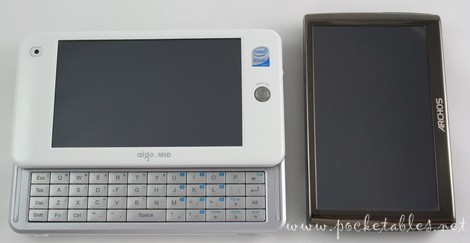
And now that we’re clear on why comparing the P8860 with the 5 isn’t the “right” thing to do, let’s do it anyway. By the way, the point of this article isn’t to reach a definitive conclusion that one MID is better than the other. All that matters is what’s better for you; I’m just laying out the facts. And here we go!
Side-by-Side Specs
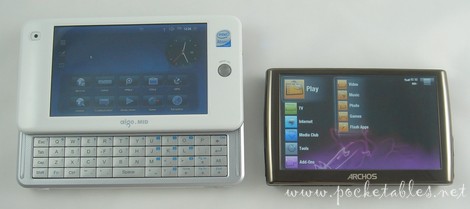
| Aigo P8860 | Archos 5 | |
| Price |
$699 | $349, $399, $449 |
| Storage |
4GB SSD | 60GB, 120GB, 250GB HDD |
| Expansion | microSD card slot | None |
| Memory | 512MB DDR2 | 128MB DDR |
| Display |
4.8″ touchscreen (800 x 480) |
4.8″ touchscreen (800 x 480, 16M colors) |
| OS | Midinux Linux | Linux (proprietary) |
| Preinstalled Applications |
Coolfox, Pidgin, PPLive video player, music player, photo viewer, ebook reader, games, stocks, office, PDF, email, contacts, calendar, dictionary, task list, calculator, audio recorder |
Opera 9, Archos Store, video player, music player, photo viewer, PDF, email, contacts, widgets (calculator, currency/unit converters, password bank, RSS, notes, weather) |
| Third-Party Applications |
Only with hacked OS | Only Opera widgets, Archos games, and Flash 9 apps |
| CPU | 800MHz Intel Atom Z500 | 600MHz ARM Cortex A8 |
| Wireless |
802.11b/g Bluetooth 2.0 GPS (?) |
802.11b/g
|
| Camera | 0.3 megapixels | None |
| I/O Ports |
Power, USB 2.0 host, USB 2.0 device, mic, headphone, microSD |
Proprietary accessory connectors, headphone |
| Keyboard | Hardware | Virtual |
| Speaker | Yes | Yes |
| Stand | No | Yes |
| Battery | Removable li-polymer | Non-removable li-polymer |
| Estimated Runtime
|
3 to 5 hours depending on usage |
Audio: up to 22 hours Video: up to 7 hours Web: up to 4 hours |
| Dimensions |
6.0″ x 3.1″ x 0.9″ | 5.0″ x 3.1″ x 0.5″ (60GB) 5.0″ x 3.1″ x 0.8″ |
| Weight |
10.6 ounces | 8.8 ounces (60GB) 10.6 ounces |
| Included Accessories |
Standard USB cable, headphones, cleaning cloth, case, AC adapter, software CD, quick start guide |
Proprietary USB cable, headphones, cleaning cloth, DVR station adapter, quick start guide |
| Optional Official Accessories |
Unknown | DVR station, DVR snap-on, GPS car holder, FM remote, mini dock, battery dock, helmet cam |
Comparison Photos


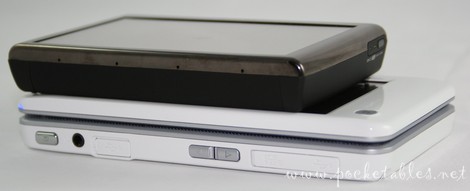


Depending on what kind of user you are and/or what you value in a portable device, you may have already made up your mind after looking at the pictures and the specs.
The Archos 5 has high entertainment value with its enormous hard drive, exceptional video playback (720p HD videos are supported with an optional plug-in), DVR capabilities, and built-in stand, while the Aigo P8860 is nicely suited for business use because of its preloaded office suite, Bluetooth 2.0, hardware keyboard, and PIM functions. It becomes less clear to identify which device excels in which areas when the internet is considered. And since the word “internet” is part of the gadget category name that each unit belongs to (i.e., Mobile Internet Device, Internet Media Tablet), it’s obviously a big consideration for both.
Website Load Times
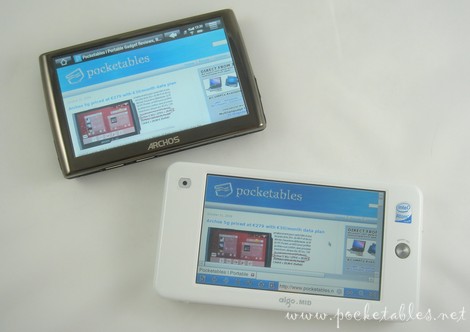
I’ll discuss the ins and outs of browsing on the P8860 and 5 in separate reviews, but what I can share now are a set of page load times recorded this afternoon. My usual guidelines apply, but I’ll repeat them in case the accusations, criticisms, and judgments (yeesh!) from the last time I did this come around again.
- This is not a scientific study or professional lab test.
- Each browser’s cache was cleared before the first set of tests.
- Load times were measured from the same location this afternoon from the click of the enter key or “Go” button in the browser’s address bar to the complete page load according to the progress bar.
- Load times vary by location, time of day, ad servers, content, etc., so your results will not be identical to mine.
One thing I did differently this time was to measure pageloads a second time. Most users don’t clear their browser’s cache after each browsing session, so I thought cached results might be useful. These times are listed in the “Pageload 2” columns below.
Note: The P8860 is capable of running desktop Firefox after a little hacking, but I’ve done the tests with the default Coolfox so that both devices are using their out-of-box browsers.
| Aigo P8860 Coolfox browser |
Archos 5 Opera 9 browser |
|||
| Pageload 1 | Pageload 2 | Pageload 1 | Pageload 2 | |
| Amazon | 12 seconds | 9 seconds | 12 seconds | 11 seconds |
| CNET | 14 seconds | 9 seconds | 24 seconds | 16 seconds |
| Digg | 8 seconds | 7 seconds | 20 seconds | 15 seconds |
| Engadget | 22 seconds | 18 seconds | 22 seconds | 17 seconds |
| Google News | 6 seconds | 6 seconds | 6 seconds | 4 seconds |
| Micro PC Talk | 11 seconds | 8 seconds | 17 seconds | 14 seconds |
| MySpace | 7 seconds | 6 seconds | 9 seconds | 8 seconds |
| NY Times |
17 seconds | 13 seconds | 21 seconds | 13 seconds |
| Pocketables |
17 seconds | 15 seconds | 18 seconds | 17 seconds |
| YouTube |
9 seconds | 6 seconds | 12 seconds | 10 seconds |
Is it any wonder that ABI Research (via Reg Hardware) predicts that almost half of all UMPCs and MIDs will be ARM-based by 2013?

